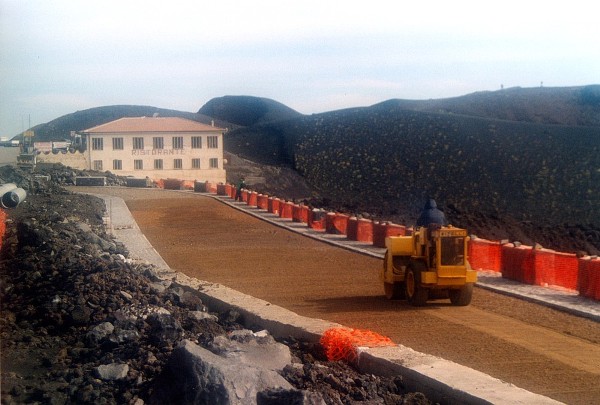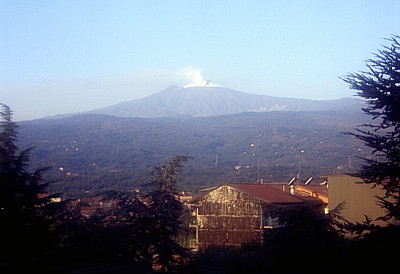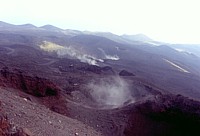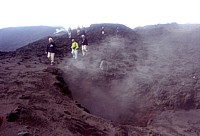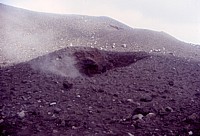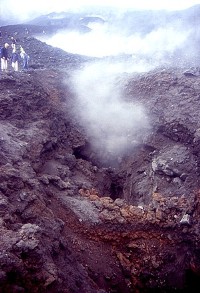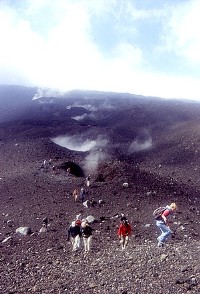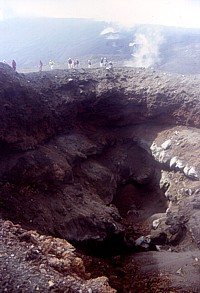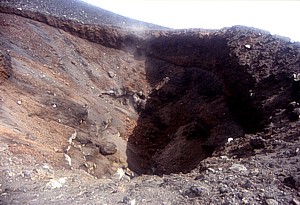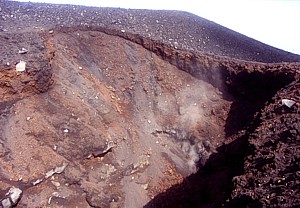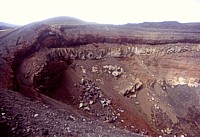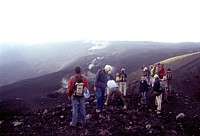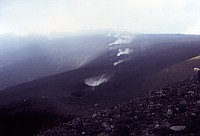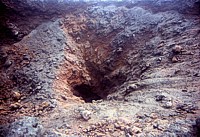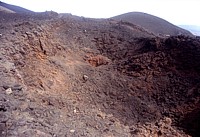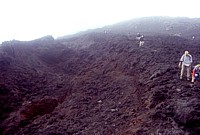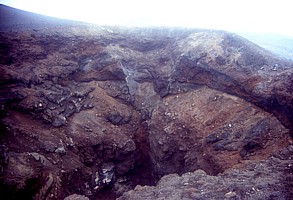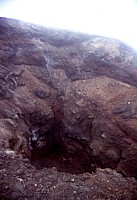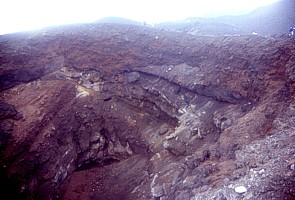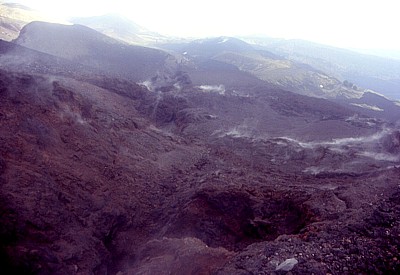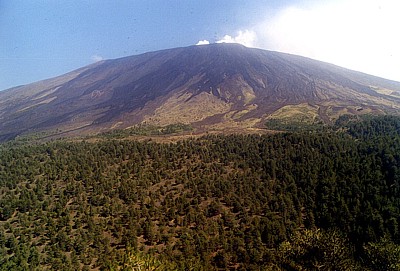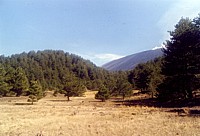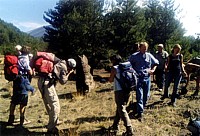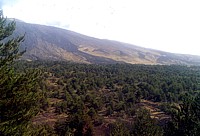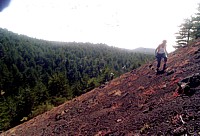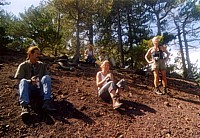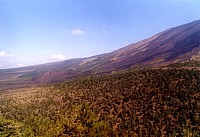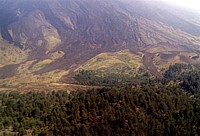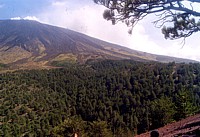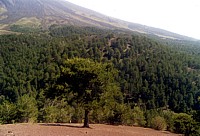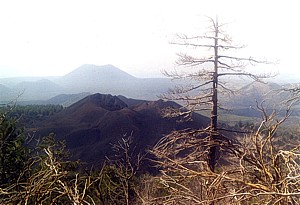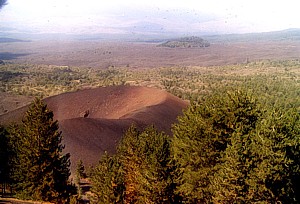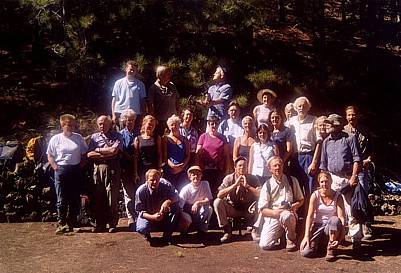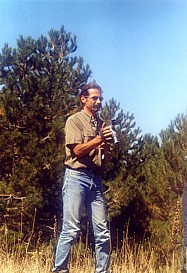| Etna
index |
||
| Geology | Geological history | Cones and craters |
| Eruptive characteristics | Eruptions before 1971 | Eruptions since 1971 |
| Etna and Man | References | Web sites |
| Weather forecasts | FAQ | Latest news |
Etna
photo gallery: 2003
Return to Etna
![]()
Part 4: September-October 2003
In late-September 2003 I finally had the chance to visit a portion of the impressive fissure opened during the Northeast Rift eruption in October 2002, which I had not seen before - the upper-central part. This section of the fissure consists of dozens of small to medium sized craters, many of them being simple pits. In the lower part of this part of the fissure, the first lava flows were emitted on the fateful day of 27 October 2002. The visit was made together with an excursion group from the University of Utrecht (Netherlands), which had been organized by the faithful Boudewijn t'Hart who has visited Etna every year since 1998. Weather conditions were not all too favourable, there was a high degree of relative humidity hampering visibility, but due to this humidity, vapor was seen escaping from many of the vents.
A
splendid morning view of Etna seen from Linguaglossa, mid-September
2003. The first snow has fallen in the summit area but has melted
on the cone of the Southeast Crater (the dark peak to the left of
the snow-covered, degassing Northeast Crater) |
The
first somewhat larger crater to open during the propagation of the
eruptive fissure of 27 October 2002 lies on the eastern side of
a low cone formed during the 1809 eruption. This crater is about
30-40 m wide and emitted fresh magmatic bombs along with blocks
of old lavas and pyroclastics pierced by this new crater. Minor
amounts of vapor are seen rising from the bottom of the crater |
|
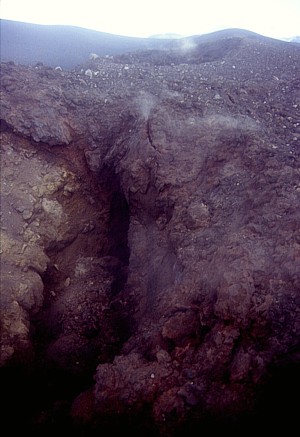 |
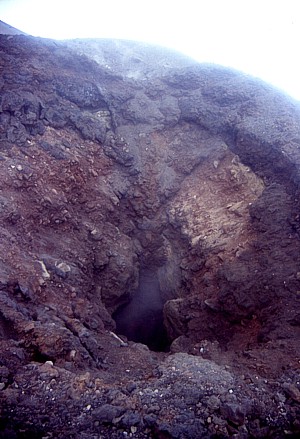 |
Looking
into two of the October 2002 vents lying next to the Piano Provenzana-summit
dirt road, with the eruptive fissure being exposed in their walls |
|
The
chaotic landscape seen in this photograph is actually the crater
(or cluster of vents) which emitted the first lava flow that descended
toward Piano Provenzana at about noon on 27 October 2002. Intense
lava fountaining was seen at this vent for several hours before
the eruptive fissure propagated further downslope (background) |
The verdant west flank, September 2003
During the same excursion with the Utrecht University group, we visited also the area of the Monti De Fiore (1974 eruption) on the west flank. This visit provided a striking contrast to the dark-toned impressions of the 2002 eruptive fissure on the Northeast Rift the day before. Much of the area surrounding the Monti De Fiore is covered with lush forest, thanks to the efforts of the Forestale (forest guards) of Etna. This is Etna's friendly side, where the volcano and its destructive potential seem to be far away - even though this landscape owes its existence to eruptions as does the somber landscape of the Northeast Rift.
The
massive western face of Etna seen from the summit of Monte Rosso,
a large prehistoric pyroclastic cone rising to a height of 1873
m. Dark tongues of lava extend from the summit of Etna down the
upper west flank, the most recent (and darkest) of which result
from the spectacular overflows from the Bocca Nuova in October--November
1999 |
Left:
the dark cone of the Monte De Fiore I, born in January-February
1974, is seen in the center of this image, in a view from the W
side of Monte Rosso. The second cone of the same eruption, formed
one month later, is largely hidden by its larger companion. The
large cone in the background is Monte Minardo, to the left of it
lies Monte Peloso and before that, Monte Tre Frati. Monte Ruvolo
is seen at extreme right. Burnt forest in the foreground is not
a result of the 1974 Monti De Fiore eruption but of a much more
recent forest fire Right: the small, horseshoe-shaped cone of Monte Mezzaluna lies on the lower north flank of Monte Rosso and is generally attributed to an eruption in February-March 1763. Recent studies by Tanguy and others show that the composition of the Monte Mezzaluna products is different from that of the other products of that eruption (Monte Nuovo), which led these scientists to assume a different (though recent) eruption date for Monte Mezzaluna |
|
Left:
excursion group of the Utrecht University, photographed at the base
of the lower of the Monti Nespole (west flank of Etna) Right: Henk Bisschop, whom I first met during the 2001 flank eruption of Etna and who is the only person to my knowledge who managed to obtain an authentical soundtrack of the powerful explosions of the large Piano del Lago cone during that eruption - seen here in action on the summit of the lower Monte Nespole |
|
Return to the Etna photo gallery
Copyright © Boris Behncke, "Italy's Volcanoes: The Cradle of Volcanology"
Page set up on 25 January 2004

